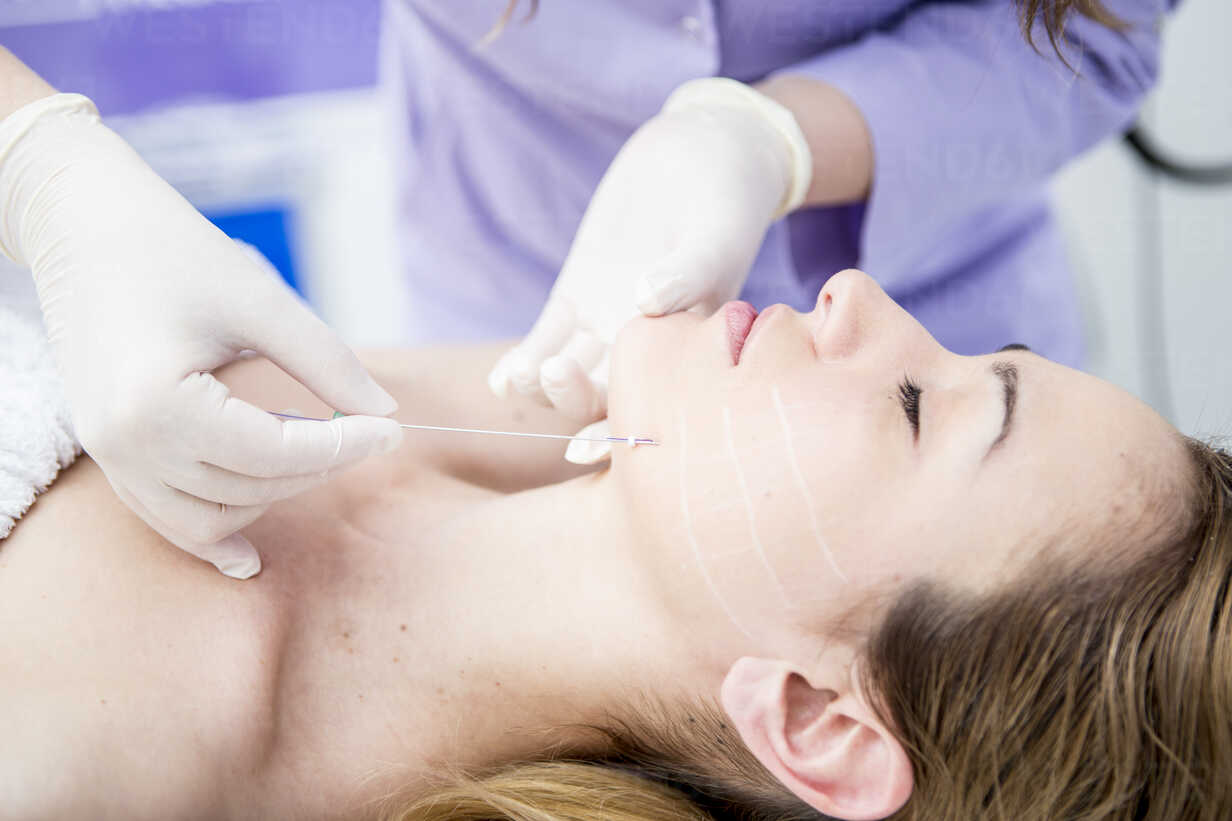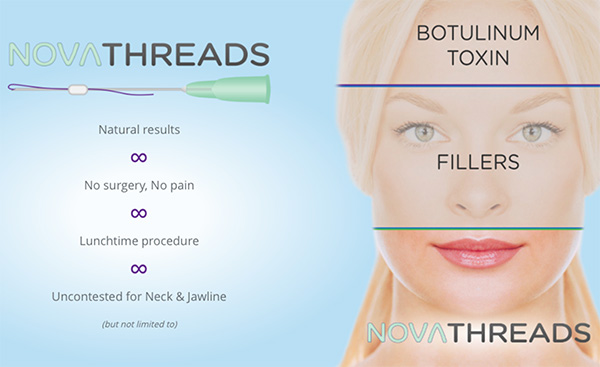Nonsurgical NovaThreads Facelift - PDO Thread Lift

What is Mono-Threading?
Mono-threading is one type of minimally-invasive aesthetic procedure known as thread lifting. It is used as an alternative to facelift surgery. In a thread lift procedure, temporary sutures are used to produce a subtle but visible “lift” in the skin. The sutures lift and tighten the skin by pulling the skin back slightly. In addition, it is proposed that the placement of the sutures provokes the body’s healing process, increasing collagen in those areas.
Collagen is a fibrous, supportive protein. It is found in bone, cartilage, tendons, ligaments, and skin. It helps skin cells adhere to one another giving the skin strength and elasticity. It also supports “growth factors” in the skin which influences skin condition. Collagen production decreases with age, contributing to skin wrinkling and sagging.


Thread-lifting procedures have been around since the 1990s but innovations in the materials and types of procedures have made them more popular in recent years. The most common areas for the procedure are the mid-face, lower face, and neck area. The type of thread used may be determined by the area on which the procedure is done.
Threads are generally classified into two broad categories: Mono and Cog. Mono threads are single, smooth threads composed of a material called PDO, polydioxanone. PDO is an absorbable polymer that has been used for many years as suture material in surgical (including cardiac) procedures and wound closure. PDO threads are absorbed by hydrolysis over a 6-month period. Mono threads most be anchored to a point on the face.
Cog threads are essentially mono threads with barbs to hook to the underside of the skin. The barbs form a support structure that lifts the sagging tissue. The production of collagen around the threads and their barbs helps to restore volume and improves the skin texture and elasticity.
Examples of FDA approved threads include NovaThread and Silhouette InstaLift. NovaThread come in several varieties- barbed, straight, or curved smooth surfaces. Smooth surfaced threads are placed near the corner of the mouth or brows, while barbed threads are more commonly used at the hairline to lift the cheeks and jowls. Silhouette InstaLift consists of a number of sutures interspersed with bidirectional tiny “cones.” These cones hook onto the skin and provide elevation that results in immediate tautness of the skin.
More recently, two additional types of threads have been introduced. PLA threads are made from a biocompatible polymer derived from lactic acid. This polymer has been used in orthopedic pins and suture material. Like PDO, PLA is resorbable but regenerates collagen for a longer period of time than PDO threads. They also use cones to hook onto the skin and create lift. PCA threads are the newest threads, composed of a synthetic caprolactone. They form long-lasting absorbable sutures. The longer duration of the material translates into more collagen and better support. Unlike the other two thread types, PCA increases both type 1 and 2-collagen, as well as hyaluronic acid, which can increase skin moisture. Both types of threads are believed to achieve longer lasting results than PDO threads.
What is the Thread-Lifting Procedure?
Thread-lift procedures are most commonly performed using local anesthesia (they can also be done with IV sedation or general anesthesia). After the skin is properly prepped, local anesthesia (usually 1% lidocaine with epinephrine) is injected into the insertion site. The threads are introduced into the skin through a fine needle- into either the skin itself, the muscle, or the subcutaneous fat. The types and number of threads inserted will depend on many factors, including the area being worked on, the age of the patient and the current condition of the skin, and whether the goal of treatment is a face lift or facial rejuvenation. After the threads are placed, the needle is removed, leaving the threads under the skin. The procedure can last 30-45 minutes.
Advantages over Surgical Facelift
Proponents of thread-lifting cite a number of potential benefits for the procedure over that of a conventional surgical face lift:
- Thread-lifting is a relatively quick procedure and is often referred to as a “lunch-hour facelift”
- Patients can return to normal activity almost immediately
- There is usually less pain and bruising than a surgical procedure
- As the procedure is done under local anesthesia, the patient can actively engage with the physician to control the degree of skin-lifting
- The procedure yields immediate results, and makes over-stretching less likely
- It is much less expensive than a surgical procedure. Thread-lifting procedures typically run between $1500-4500. This is estimated to be about 40% of the cost of a surgical facelift
Side Effects or Complications
- Bruising, swelling, bleeding, slight pain at the thread injection site
- Thread protrusion, puckering of the skin
- Bleeding/bruising/hematoma
- Infection, granuloma
- Swelling/inflammation
- Migration (of threads or barbs)
- Asymmetry
- Facial nerve trauma
- Stinging/scratching/pulling sensations
- Allergic reaction
How Long Do the Results Last?
This is the (multi-)million-dollar question when it comes to thread-lifting procedures. Not surprisingly, thread-lifting results will not last as long as surgical facelift procedures.
Unfortunately, there aren’t many scientific studies that look at this question. Those that do exist are often inconclusive. For example, an article in Aesthetic Surgery Journal looked at 160 patients who underwent a thread-lifting procedure for malar augmentation or correction of nasolabial grooves. They noted universal improvement immediately after the procedure. However, the effect declined noticeably by 6 months and was gone by 1 year. Another review in 2018 covering 12 studies concluded, “All included literature…, except two studies, demonstrated at best a very limited durability of the lifting effect. The two positive studies were sponsored by the companies that manufacture the thread-lift sutures.” Likewise, authors of a 2018 Viewpoint article in JAMA Facial Plastic Surgery, reviewing studies of the past 10 years, said, “We continue to be skeptical regarding the long-term efficacy of thread-lifting. Despite the continued use, scientific studies on longevity are still lacking.”


